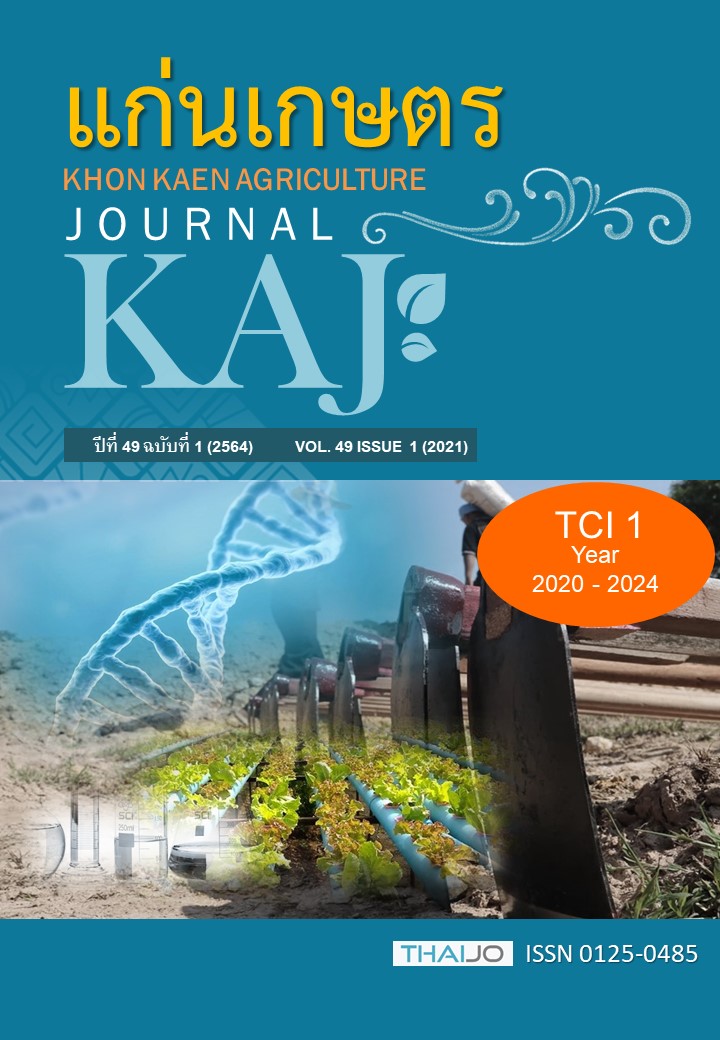สถานะของเหล็กในพื้นที่กุลาร้องไห้และการตอบสนองของข้าวขาวดอกมะลิ 105 ต่อปุ๋ยเหล็กที่ให้ทางใบ
Main Article Content
บทคัดย่อ
ศึกษาสถานะของเหล็กในดินในพื้นที่กุลาร้องไห้และผลของปุ๋ยเหล็กต่อข้าวขาวดอกมะลิ 105 ที่ปลูกในชุดดินร้อยเอ็ด ดินคล้ายชุดดินร้อยเอ็ดที่เป็นดินเค็มและชุดดินพิมายซึ่งเป็นดินที่ได้รับอิทธิพลของเกลือโดยทำการทดสอบฉีดพ่นเหล็กทางใบในอัตรา 0, 0.25, 0.5 และ 1 กก./ไร่ในระยะแตกกอ หรือ ระยะออกดอก พบว่า เหล็กในดินส่วนใหญ่อยู่ในรูปทั้งหมดซึ่งเป็นองค์ประกอบของแร่ในดิน รูปที่สกัดได้ในดินจะมีปริมาณมากที่สุดเมื่อสกัดด้วยสารละลาย DTPA-AB แต่คงอยู่ในสัดส่วนที่น้อยกว่าเหล็กทั้งหมดอย่างชัดเจน เช่นเดียวกับเหล็กที่ละลายน้ำที่พืชดูดใช้ได้ทันทีมีอยู่น้อยมาก การฉีดพ่นเหล็กทางใบทำให้น้ำหนักตอซังและผลผลิตเมล็ดของข้าวเพิ่มขึ้นทางสถิติโดยการฉีดพ่นในอัตรา 0.25 กก./ไร่ที่ระยะแตกกอให้น้ำหนักตอซังข้าวในชุดดินร้อยเอ็ดสูงสุดเท่ากับ 541 กก./ไร่ และน้ำหนักเมล็ดข้าวในชุดดินร้อยเอ็ดและดินคล้ายชุดดินร้อยเอ็ดที่เป็นดินเค็มสูงสุดอย่างมีนัยสำคัญทางสถิติเท่ากับ 248 และ 144 กก./ไร่ตามลำดับ การฉีดพ่นเหล็กในอัตรา 1 กก./ไร่ที่ระยะเดียวกันยังให้น้ำหนักเมล็ดข้าวในชุดดินพิมายสูงสุดอย่างมีนัยสำคัญทางสถิติเท่ากับ 262 กก./ไร่ การฉีดพ่นเหล็กที่ระยะแตกกอทำให้ได้น้ำหนักตอซังและผลผลิตเมล็ดของข้าวสูงกว่าการฉีดพ่นที่ระยะออกดอกอย่างมีนัยสำคัญทางสถิติ การฉีดพ่นเหล็กทางใบส่วนใหญ่ทำให้ข้าวสะสมและดูดใช้ธาตุอาหารหลักเพิ่มขึ้นทางสถิติ ผลผลิตเมล็ดและน้ำหนักแห้งตอซังของข้าวมีสหสัมพันธ์ผกผันกับความเข้มข้นของเหล็กในแกลบและรำ (r= -0.43** และ -0.29**) ส่วนร้อยละเมล็ดดีมีสหสัมพันธ์เชิงเส้นกับความเข้มข้นของเหล็ก (r= 0.21*) แต่มีสหสัมพันธ์ผกผันกับความเข้มข้นของไนโตรเจน (r=-0.72**) ในเมล็ดข้าว
Article Details

อนุญาตภายใต้เงื่อนไข Creative Commons Attribution-NonCommercial-NoDerivatives 4.0 International License.
เอกสารอ้างอิง
ทัศนีย์ อัตตะนันทน์. 2550. ดินที่ใช้ปลูกข้าว พิมพ์ครั้งที่ 4 สำนักพิมพ์มหาวิทยาลัยเกษตรศาสตร์.กรุงเทพมหานคร.
แสงนวล ทองเพียร และ อัมรา เวียงวีระ. 2548. ลักษณะพิเศษของข้าวหอมมะลิ. กสิกร 78: 6-11.
อัจฉรา ดลวิทยาคุณ. 2550. พื้นฐานโภชนาการ. โอเดียนสโตร์, กรุงเทพฯ.
เอมอร วสันตวิสุทธิ์ และ รัชนี คงคาฉุยฉาย. 2546. สังกะสี, น. 274-282. ใน สุปรานี แจ้งบำรุง, ประไพศรี ศิริจักรวาล, ประภาศรี ภูวเสถียร, เบ็ญจลักษณ์ ผลรัตน์, อุไรพร จิตต์แจ้ง, สุภัจฉรา นพจินดา, อรวรรณ ภู่ชัยวัฒนานนท์, ทิพยเนตร อริยปิติพันธ์ และ สุจิตต์ สาลีพันธ์ บรรณาธิการ. ปริมาณสารอาหารอ้างอิงที่ควรได้รับประจำวันสำหรับคนไทย. โรงพิมพ์องค์การรับส่งสินค้าและพัสดุภัณฑ์, กรุงเทพฯ.
Brady, N.C., and R.R. Weil. 2016. The Nature and Properties of Soils. 15th Person, Prentice Hall, New York.
Buchanan, B.B., W. Gruissem, and R.L. Jones. 2015. Biochemistry and Molecular Biology of Plants: John Wiley & Sons.
Chen, M., and L.Q. Ma. 2001. Comparison of three aqua regia digestion methods for twenty Florida soils. Soil Science Society of America Journal. 65: 491–499.
Dobermann, A., and T. Fairhurst. 2000. Rice: Nutrient Disorders and Nutrient Manangement. Potash and Phosphate Institute. Canada.
Duraisamy, P., and A.K. Mani. 2001. Effect of iron and molybdenum on yield and nutrition of horse gram in red loamy sand soil. Mysore Journal of Agricultural Sciences. 35: 297-301.
Fageria, N.K. 2014. Mineral Nutrition of Rice. Boca Raton, FL: CRC Press.
Fang, Y., L. Wang, Z. Xin, L. Zhao, X. An, and Q. Hu. 2008. Effect of foliar application of zinc, selenium, and iron fertilizers on nutrients concentration and yield of rice grain in China. Journal of Agricultural and Food Chemistry. 56: 2079-2084.
Kabata-Pendias, A., and H. Pendias 2001. Trace Elements in Soils and Plants, 3th edition. CRC Press LLC.
Kohlmeier, M. 2003. Nutrient Metabolism. Academic Press, California.
Kumar, V., D. Kumar, Y.V. Singh, R. Raj, and N. Singh. 2018. Effect of iron nutrition on plant growth and yield of aerobic rice. International Journal of Chemical Studies. 6: 999-1004.
Lindsay, W.L., and W.A. Norvell. 1978. Development of DTPA soil test for zinc, iron, manganese and copper. Soil Science Society of America Journal. 42: 421-42.
Lursinsap, T. 2002. Zinc in Human Nurtrition. Available Source: http://www.sci.ru.ac.th/chem/web%20genchem%202002/research%20%20page_1/paper/ZN.pdf, Accessed November 17, 2015.
Mehlich, A. 1984. Mehlich 3 soilextractant: A modification of Mehlich 2 extractant. Communications in Soil Science and Plant Analysis. 15: 1409-1416.
Sanchez, P.A. 2019. Properties and Management of Soils in the Tropics: Cambridge University Press.
Soltanpour, P.N., and A.P. Schwab. 1977. A new soil test for macro- and micro-nutrients in alkaline soils. Communications in Soil Science and Plant Analysis. 8: 195-207.
Sorensen, R.C., D.D. Oelsligle, and D. Knuden. 1971. Extraction of Zn, Fe and Mn from soils with 0.1 M hydrochloric acid as affected by soil properties, solution, soil ratio; and length of extraction period. Soil Science. 11: 352-359.
Welch, R.M., and R.D. Graham. 2004. Breeding for micronutrients in staple food crops from a human nutrition perspective. Journal of Experimental Botany. 55: 353-364.
Xiaoyun, F., Md. K. Rezaul, C. Xinping, Z. Yueqiang, G. Xiaopeng, Z. Fusuo, and Z. Chunqin. 2012. Growth and iron uptake of lowland and aerobic rice genotypes under flooded and aerobic cultivation. Communications in Soil Science and Plant Analysis. 43: 1811-1822
Yusiharni, E., and R.J. Gilkes. 2012. Minerals in the ash of Australian native plants. Geoderma. 189: 369-380.
Zayed, B.A., A.K.M. Salem, and H.M. El Sharkawy 2011. Effect of different micronutrient treatments on rice (Oriza sativa L.) growth and yield under saline soil conditions. World Journal of Agricultural Sciences. 7: 179-184.
Zhang, J., K. Chen, Y. Pang, S.A. Naveed, X. Zhao, X. Wang, Y. Wang, M. Dingkuhn, J. Pasuquin, Z. Li, and J. Xu. 2017. QTL mapping and candidate gene analysis of ferrous iron and zinc toxicity tolerance at seedling stage in rice by genome-wide association study. BMC Genomics 18: 828, DOI 10.1186/s12864-017-4221-5
Zhang, J., M. Wang, and L. Wu. 2009. Can foliar iron-containing solutions be a potential strategy to enrich iron concentration of rice grains (Oryza sativa L.)?. Acta Agriculturae Scandinavica. 59: 389-394.


